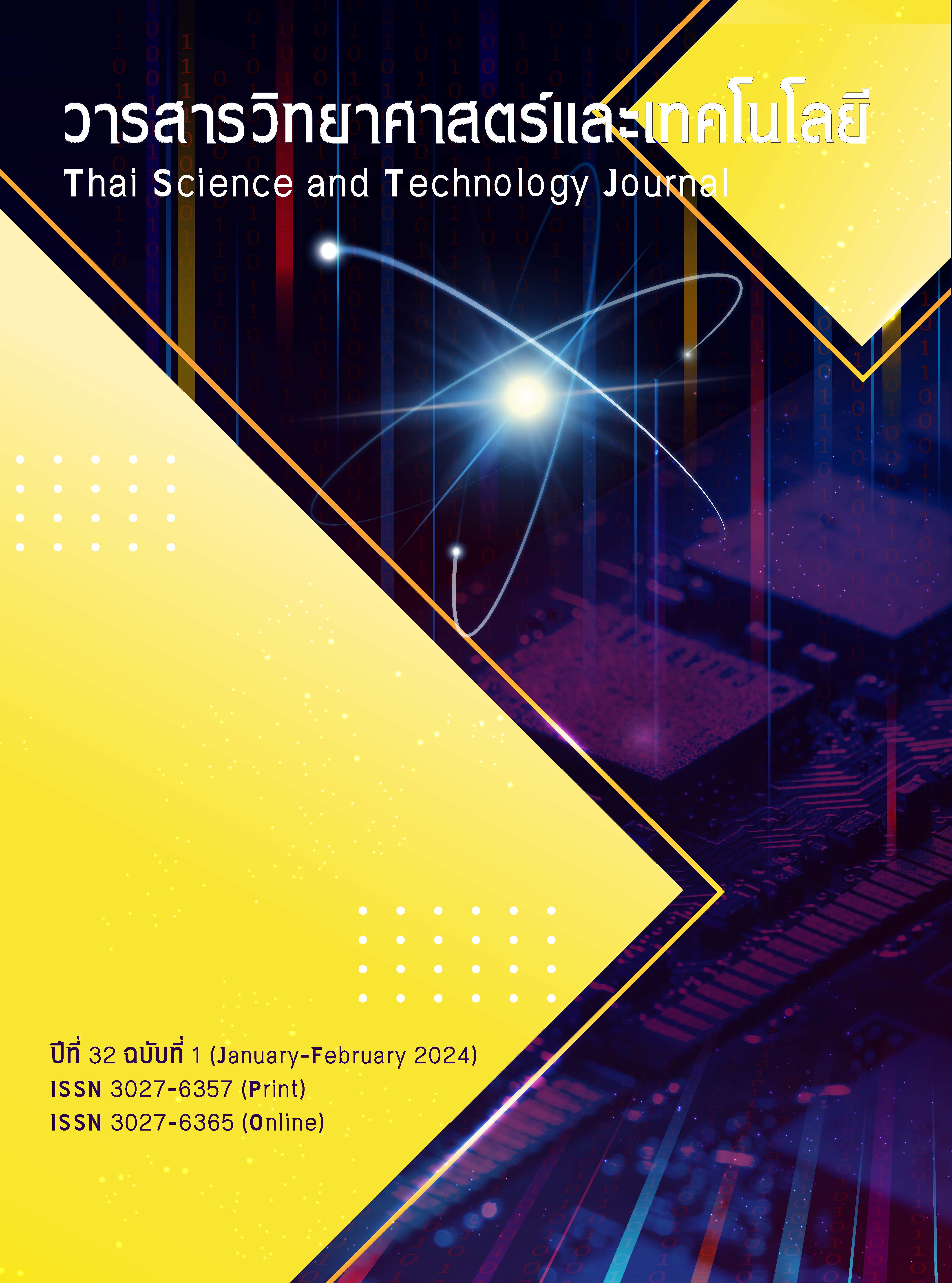Biochar Production from Shuttlecocks by Hydrothermal Carbonization
Main Article Content
Abstract
The shuttlecocks discarded from the sports activity were subjected to hydrothermal carbonization under three parameters: temperature (180, 200 and 220 °C), time (30, 60 and 90 min) and solid/water ratio (0.05, 0.07 and 0.10 by wt.). Temperature exhibited a significant effect on yield, time showed a significant effect on higher heating value, while a combination of temperature and time had an effect on both yield and higher heating value. The obtained biochars displayed higher carbon content, with a higher heating value ranging from 28,000 to 30,000 kJ/kg. They exhibited lower hydrogen content, oxygen content, and H/C and O/C atomic ratios, resembling the characteristics of Sporinite and Cutinite coals. This suggests their potential suitability for use as cooking fuel. The optimum conditions for application are within a temperature range 180-200 °C and a time of 30 minutes.
Article Details
References
Liang, H., 2021, A visit to the township that produces 60 million badminton shuttlecocks a year, Available Source: http://en.people.cn/n3/2021/0811/c90000-9882629.html, April 10, 2022.
Whittemore, F., 2018, Badminton Equipment Regulations, Available Source: https://www.sportsrec.com/5590266/badminton-equipment-regulations, May 10, 2022.
Sen, U., Martins, M., Santos, Ev, Lemos, M., Lemos, F. and Pereira, H., 2022, Slow Pyrolysis of Quercus cerris Cork: Characterization of Biochars and Pyrolysis Volatiles, Environments. 10(1).
Thallada, B. and Ashok, P., Advances in Thermochemical Conversion of Biomass - Introduction, in Recent Advances in Thermochemical Conversion of Biomass, Elsevier USA. p. 3-30.
Phillip, S., 1999, Organic chemical reactions in supercritical water, Chemical reviews. 99(2).
Tanveer, A., Hyun, K., Arun, G., Saidatul, J. and Rajan, J., 2018, Synthesis and characterization of carbon microspheres from rubber wood by hydrothermal carbonization, J. Chem. Technol. Biotechnol. 94(5): 1374-1383.
Hoekman, K., Broch, A., Robbins, C., Zielinska, B. and Felix, L., 2012, Hydrothermal carbonization (HTC) of selected woody and herbaceous biomass feedstocks, Biomass Convers. Biorefin. 3(2): 113-126.
Stefan, A., Andre, P., Steffen, T., Horst, S., Michael, F. and Gerd, W., 2013, Impact of biochar and hydrochar addition on water retention and water repellency of sandy soil, Geoderma. 202-203: 183-191.
Erdogan, E., Atila, B., Mumme, J., Reza, T., Toptas, A., Elibol, M. and Yanik, J., 2015, Characterization of products from hydrothermal carbonization of orange pomace including anaerobic digestibility of process liquor, Bioresour Technol. 196: 35-42.
Parshetti, G., Chowdhury, S. and Balasubramanian, R., 2014, Hydrothermal conversion of urban food waste to chars for removal of textile dyes from contaminated waters, Bioresour Technol. 161: 310-9.
Parshetti, G., Liu, Z., Jain, A., Srinivasan, M. and Balasubramanian, R., 2013, Hydrothermal carbonization of sewage sludge for energy production with coal, Fuel. 111: 201-210.
Alatalo, S., Repo, E., Makila, E., Salonen, J., Vakkilainen, E. and Sillanpaa, M., 2013, Adsorption behavior of hydrothermally treated municipal sludge & pulp and paper industry sludge, Bioresour Technol. 147: 71-76.
Du, Z., Hu, B., Shi, A., Ma, X., Cheng, Y., Chen, P., Liu, Y., Lin, X. and Ruan, R., 2012, Cultivation of a microalga Chlorella vulgaris using recycled aqueous phase nutrients from hydrothermal carbonization process, Bioresour Technol. 126: 354-7.
Heilmann, S., Molde, J., Timler, J., Wood, B., Mikula, A., Vozhdayev, G., Colosky, E., Spokas, K. and Valentas, K., 2014, Phosphorus reclamation through hydrothermal carbonization of animal manures, Environ. Sci. Technol. 48(17): 10323-9.
Judy, L., Kyoung, R., Claudia, K., Axel, F., Nicole, B., York, N., Maria-Magdalena, T., Christoph, F., Oliver, B., Jürgen, K. and Karl-Heinz, E., 2011, Hydrothermal carbonization of biomass residuals: a comparative review of the chemistry, processes and applications of wet and dry pyrolysis, Biofuels. 2(1): 71-106.
Reza, T., Andert, J., Wirth, B., Busch, D., Pielert, J., Lynam, J. and Mumme, J., 2014, Hydrothermal Carbonization of Biomass for Energy and Crop Production, Applied Bioenergy. 1(1).
Harpreet, K. and Animesh, D., 2015, A comparative review of biochar and hydrochar in terms of production, physico-chemical properties and applications, Renew. Sust. Energ. Rev. 45: 359-378.
Peitao, Z., Yafei, S., Shifu, G., Zhenqian, C. and Kunio, Y., 2014, Clean solid biofuel production from high moisture content waste biomass employing hydrothermal treatment, Appl. Energy. 131: 345-367.
Minitab, LLC. (n.d.), Minitab Statistical Solfware (Version 21) [Computer solfware], Available Source: https://www.minitab.com/en-us/products/minitab/free-trial/.
Lachos-Perez, D., Torres-Mayanga, P., Abaide, E. R., Zabot, G. L. and Castilhos, F., 2022, Hydrothermal carbonization and Liquefaction: differences, progress, challenges, and opportunities, Bioresour Technol. 343.
Montero, I., Miranda, T., Sepulveda, F. J., Arranz, J. I. and Nogales, S., 2014, Analysis of Pelletizing of Granulometric Separation Powder from Cork Industries, Materials (Basel). 7(9): 6686-6700.
John, M., 2018, Density of wood in kg/m3, g/cm3, lb/ft3 – the ultimate guide, Available Source: https://www.engineeringclicks.com/density-of-wood/, July 25, 2023.
Kang, K., Nanda, S., Sun, G., Qiu, L., Gu, Y., Zhang, T., Zhu, M. and Sun, R., 2019, Microwave-assisted hydrothermal carbonization of corn stalk for solid biofuel production: Optimization of process parameters and characterization of hydrochar, Energy. 186.
Sattasathuchana, S., Parnthong, J., Youngian, S., Faungnawakij, K., Rangsunvigit, P., Kitiyanan, B., Khunphonoi, R., Wanichsombat, A., Grisdanurak, N. and Khemthong, P., 2023, Energy efficiency of bio-coal derived from hydrothermal carbonized biomass: Assessment as sustainable solid fuel for municipal biopower plant, Appl. Therm. Eng. 221.
Clara, G. and Marco, R., 2021, Coal petrology analysis and implications in depositional environments from upper Cretaceous to Miocene: a study case in the Eastern Cordillera of Colombia, Int. J. Coal. Sci. Technol. 8(5): 869-896.


